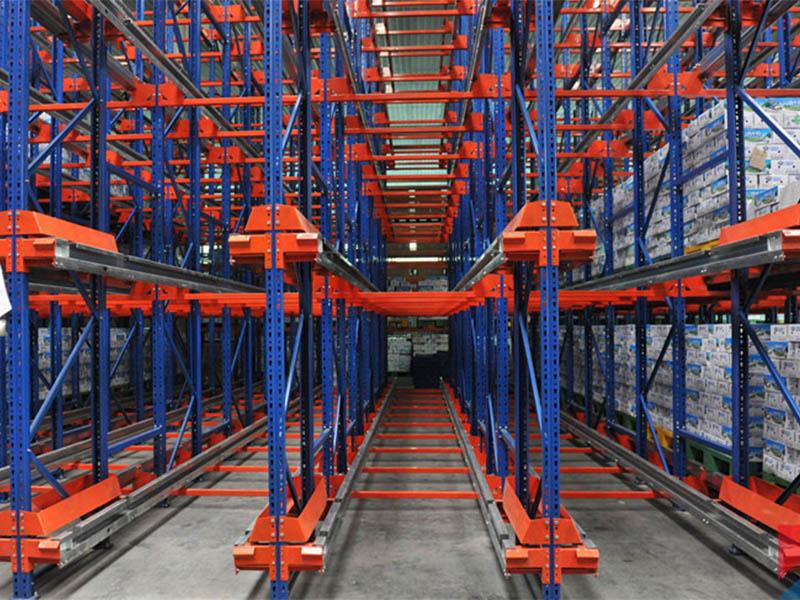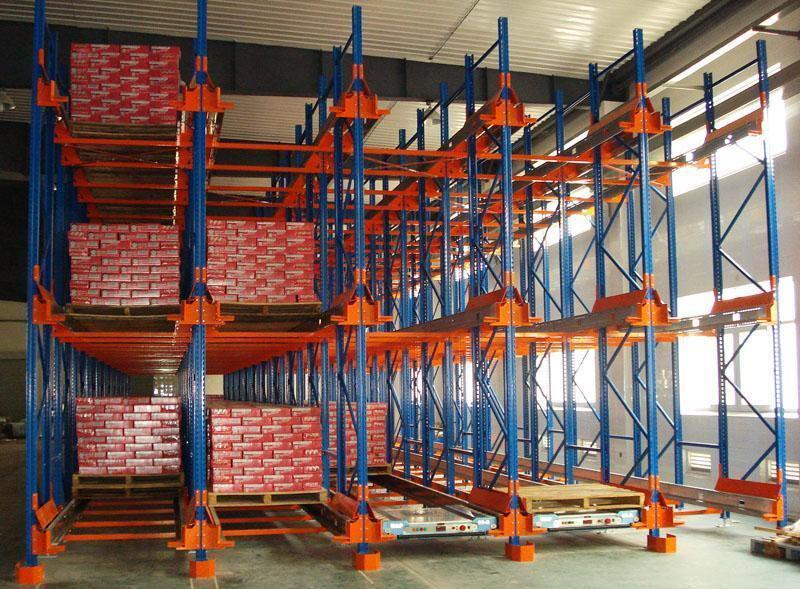In the relentless pursuit of warehouse efficiency, speed, and accuracy, automation has become paramount. Among the innovative solutions transforming storage and retrieval operations, the shuttle rack system stands out as a sophisticated and highly effective technology. This article delves deep into the world of shuttle rack systems, exploring their design, functionality, benefits, applications, and considerations for implementation. Understanding the shuttle rack is crucial for any logistics or warehouse manager aiming to optimize their storage density and throughput.

1. How Does a Shuttle Rack System Operate? The Core Mechanism
At its heart, a shuttle rack system automates the movement of pallets or bins within a high-density storage structure, typically utilizing a drive-in or push-back rack configuration. Unlike traditional systems requiring forklifts to enter the lane, the shuttle rack employs a key component: the autonomous, battery-powered shuttle car.
•The Shuttle Car: This robotic device runs on rails installed at each level of the storage lane. Controlled by a central Warehouse Management System (WMS) or Warehouse Control System (WCS), the shuttle receives instructions via radio or infrared signals.
•Loading/Unloading: A forklift operator places a pallet onto the shuttle car at the front of the lane. The shuttle then autonomously transports the pallet deep into the lane to the designated storage location. For retrieval, the shuttle travels to the required pallet position, lifts it slightly, and brings it back to the front of the lane for the forklift to pick up.
•Lane Management: Each storage lane typically requires one shuttle per level. However, some advanced systems allow a single shuttle to be manually or automatically transferred between levels or even between adjacent lanes (using transfer cars or lifts), optimizing resource utilization. The shuttle rack essentially transforms deep storage lanes into automated, high-throughput channels.
•Sequence Handling: Shuttle rack systems excel at managing First-In-First-Out (FIFO) or Last-In-First-Out (LIFO) inventory sequences efficiently within each lane, dictated by the WMS logic.
The core magic of the shuttle rack lies in this automation of the horizontal movement within the dense storage structure, drastically reducing forklift travel time and associated risks.
2. Structural Design and Components of a Shuttle Rack System
A shuttle rack system is more than just the robotic car; it's an integrated structure designed for automation and high density:
•Racking Structure: Built to withstand significant loads, the racking resembles a very robust drive-in rack system. It features guide rails installed precisely along the length of each storage level within a lane. These rails provide the track for the shuttle car to move on.
•Shuttle Car: The workhorse of the system. Modern shuttle cars are equipped with:Electric motor and wheels for propulsion.Lifting mechanism (often scissor lifts or forks) to raise/lower pallets slightly off the rails for movement.Onboard battery (charged automatically at docking stations or during idle times).Sensors (for position detection, obstacle avoidance, load presence).Communication module (Wi-Fi, infrared) to interface with the control system.
•Transfer Carts/Lifts (Optional but Common): For systems with multiple levels or adjacent lanes, transfer carts move shuttle cars horizontally between lanes at the same level, while lifts move them vertically between different levels. This reduces the number of shuttle cars needed per system.
•Charging Stations: Designated points, often at the lane entrance, where the shuttle car automatically docks to recharge its battery between operations.
•Control System: The brain of the operation. A sophisticated WMS/WCS manages inventory location, sends commands to the shuttle cars, coordinates transfers, monitors battery levels, and provides operational data and alerts. This system integrates seamlessly with the shuttle rack hardware.
•Safety Features: Integrated sensors, emergency stop functions, communication protocols, and physical barriers ensure safe interaction between the automated shuttle, human operators, and the racking structure.
The shuttle rack design prioritizes precision, durability, and seamless integration between the physical structure and the robotic automation components.

3. Key Advantages and Benefits of Implementing a Shuttle Rack
Adopting a shuttle rack system offers a compelling array of benefits that directly impact warehouse productivity and the bottom line:
•Significantly Increased Storage Density: By enabling very deep lanes (often 10+ pallet positions deep) and utilizing height effectively, shuttle rack systems dramatically increase pallet positions per square meter compared to selective pallet racking, often approaching the density of drive-in racks but with vastly superior accessibility and speed.
•Enhanced Operational Efficiency & Throughput: Automation drastically reduces the time required for storing and retrieving pallets deep within lanes. Forklifts only operate at the lane front, performing quick drop-off and pick-up, while the shuttle handles the time-consuming internal travel. This leads to faster cycle times and higher overall warehouse throughput.
•Reduced Labor Costs and Dependency: Automating the horizontal movement within lanes minimizes the need for highly skilled forklift operators for deep storage tasks. Fewer operators can manage more storage volume, leading to substantial labor cost savings and reduced reliance on scarce labor resources.
•Improved Safety: Eliminating the need for forklifts to enter deep, narrow storage lanes significantly reduces the risk of accidents, collisions with racking, and product damage caused by forklift operation in confined spaces. The shuttle rack confines high-speed movement to the automated component.
•Greater Accuracy and Reduced Product Damage: Controlled by the WMS/WCS, the shuttle car retrieves the exact pallet required, minimizing human selection errors. Gentle, programmed handling by the shuttle also reduces the risk of product damage compared to manual forklift handling in tight spaces.
•Optimized Inventory Management (FIFO/LIFO): The system effortlessly manages inventory rotation (FIFO or LIFO) within each lane as programmed, ensuring stock integrity and compliance, which is crucial for perishable goods or items with expiry dates.
•Scalability and Flexibility: Shuttle rack systems can often be implemented in phases. Additional lanes, levels, or shuttle cars can be integrated as storage needs grow. The system can handle various pallet sizes and weights (within design limits).
The shuttle rack delivers a powerful combination of space savings, speed, safety, and operational cost reduction.
4. Primary Applications and Industries for Shuttle Rack Systems
Shuttle rack technology is versatile and finds application in numerous industries where high-density storage and efficient handling of large volumes of goods are critical:
•Cold Storage and Frozen Warehousing: This is a prime application. The high density maximizes valuable chilled/frozen space, while minimizing the time refrigerated doors are open (as forklifts stay outside). Reduced labor exposure to extreme cold is a major safety benefit. The shuttle rack excels in these harsh environments.
•Food and Beverage: Ideal for storing large quantities of homogeneous products like beverages, packaged foods, or ingredients requiring FIFO management. The shuttle rack ensures efficient rotation and handling.
•Bulk Storage and Distribution Centers: For businesses storing large quantities of SKUs with medium to slow turnover, shuttle rack systems offer the perfect blend of high density and acceptable retrieval times, optimizing warehouse footprint in large DCs.
•Manufacturing: Storing raw materials or finished goods efficiently near production lines. Buffer storage for WIP (Work-in-Progress) can also benefit.
•Retail Logistics: Supporting the storage of high-volume products destined for retail stores, especially where space is at a premium in regional distribution centers.
•Beverage Industry: Exceptionally well-suited for storing large volumes of homogeneous pallets like beer, soda, or water, where high density and efficient loading/unloading for delivery trucks are paramount. The shuttle rack is a common sight in major beverage distribution.
•Any High-Volume, Medium-Slow Moving Goods: Essentially, any operation storing large quantities of palletized goods that don't require instantaneous, selective access (which is better suited for AS/RS) can benefit from the density and efficiency of a shuttle rack.
The shuttle rack shines where maximizing pallet count within a defined footprint is a primary goal, and throughput requirements align with its automated retrieval speeds.
5. Critical Considerations for Choosing and Implementing a Shuttle Rack
While powerful, implementing a shuttle rack system requires careful planning and consideration:
•Initial Investment Cost: The technology (shuttles, control system, specialized racking) involves a significantly higher upfront investment compared to conventional racking. A detailed ROI analysis considering labor savings, space savings, and productivity gains is essential.
•SKU Profile and Homogeneity: Shuttle rack systems are most efficient when handling a limited number of SKUs in high volume per lane. Each lane typically stores only one SKU to maximize efficiency. Operations with a vast number of unique SKUs each with low volume may not be ideal.
•Throughput Requirements: While faster than manual drive-in systems, shuttle rack throughput per lane has limits. Analyze peak demands to ensure the number of lanes and shuttle cars can handle required store/retrieve cycles. Adding more shuttle cars or lanes increases capacity.
•Integration Complexity: Seamless integration with the existing or new WMS/WCS is critical for optimal performance. This requires expertise and potentially middleware. Ensure the shuttle rack supplier offers robust integration capabilities.
•Maintenance and Support: Automated systems require proactive maintenance plans and reliable technical support. Understand the supplier's service level agreements (SLAs), spare parts availability, and the technical skill set required in-house. Downtime can be costly.
•Building Considerations: Floor flatness requirements are stringent for smooth shuttle operation. Column spacing, clear heights, and floor load capacity must accommodate the dense, potentially heavier-loaded structure. Fire protection strategies need adaptation for high-density storage.
•Choosing the Right Supplier/Partner: Select a reputable supplier with proven experience in shuttle rack installations. Evaluate their technology reliability, software capabilities, after-sales service, and ability to provide a tailored solution. References are crucial.
•Scalability Planning: Design the initial phase with future expansion in mind. Consider how easily additional lanes, levels, or shuttle cars can be integrated later.
Successfully implementing a shuttle rack hinges on thorough analysis, choosing the right application, selecting a capable partner, and meticulous planning for integration and operation.
The shuttle rack system represents a significant leap forward in pallet storage technology, offering an exceptional balance between ultra-high density and automated accessibility. By deploying autonomous shuttle cars within deep storage lanes, it eliminates the inefficiencies and safety hazards associated with manual forklift operation in confined spaces. The benefits – dramatic space savings, increased throughput, reduced labor costs, enhanced safety, and improved inventory accuracy – make it a compelling solution for cold storage, beverage distribution, food and beverage logistics, and any operation handling high volumes of homogeneous palletized goods with medium to slow turnover.
While the initial investment is substantial, the long-term operational savings and efficiency gains often deliver a strong return on investment. Careful consideration of SKU profile, throughput needs, integration requirements, and choosing the right partner are vital for a successful implementation. As warehouses continue to face pressures to do more with less space and labor, the shuttle rack stands as a sophisticated and increasingly essential tool in the logistics automation arsenal, transforming dense storage from a challenge into a competitive advantage. Investing in a shuttle rack system is an investment in the future efficiency and scalability of your warehouse operations.







